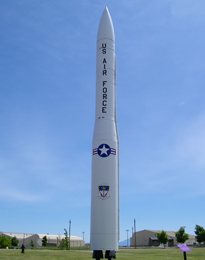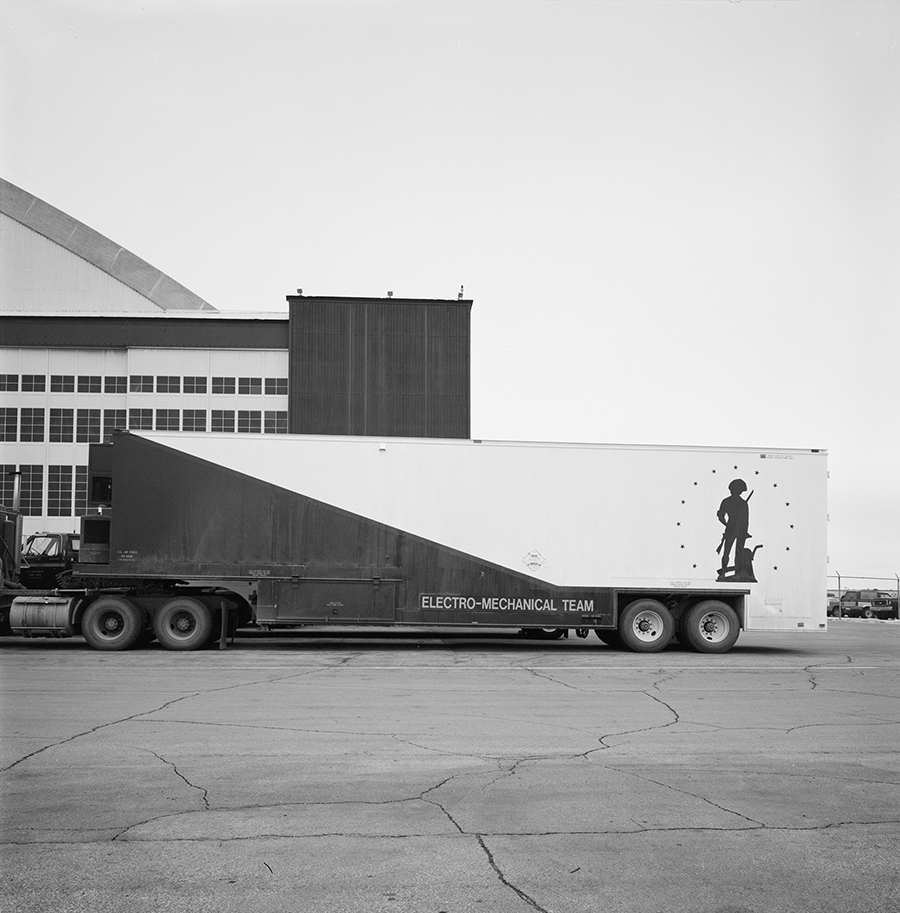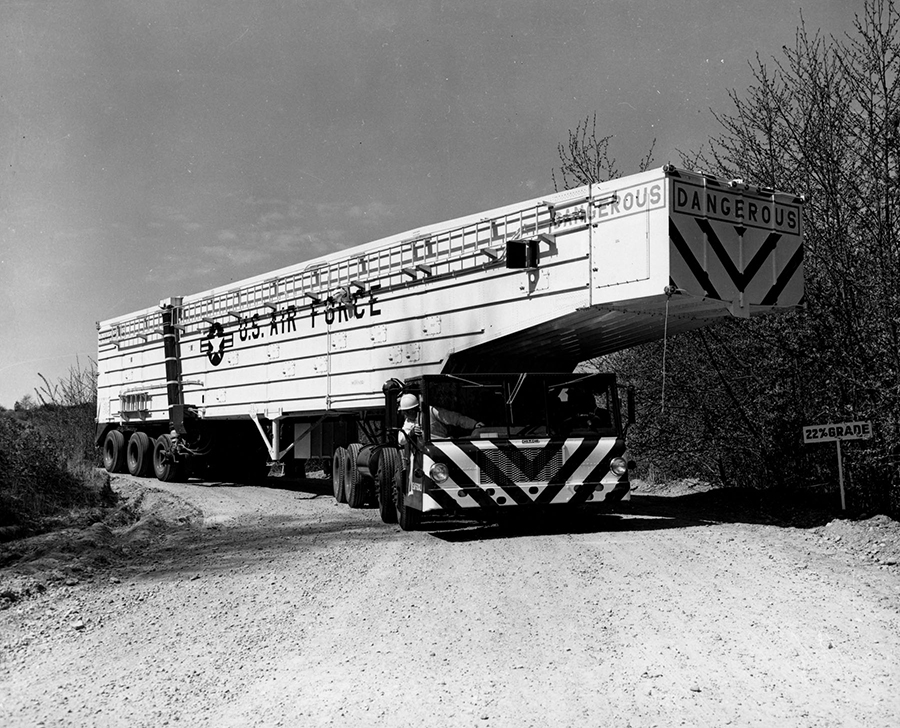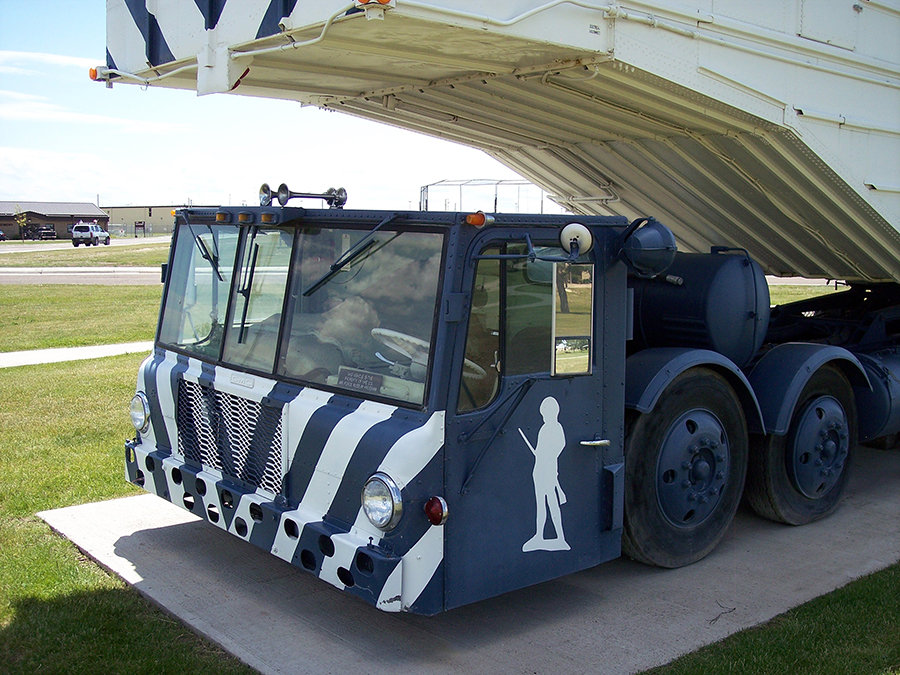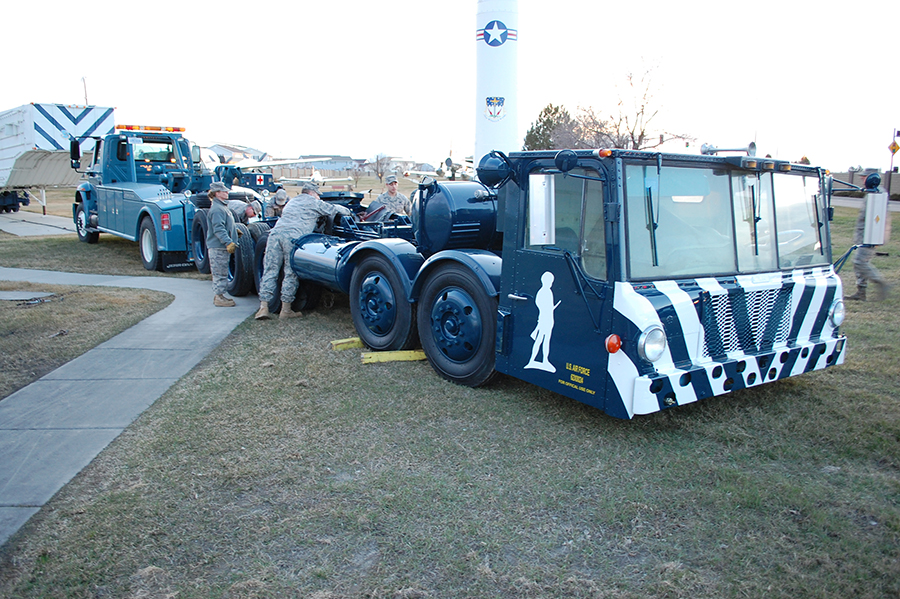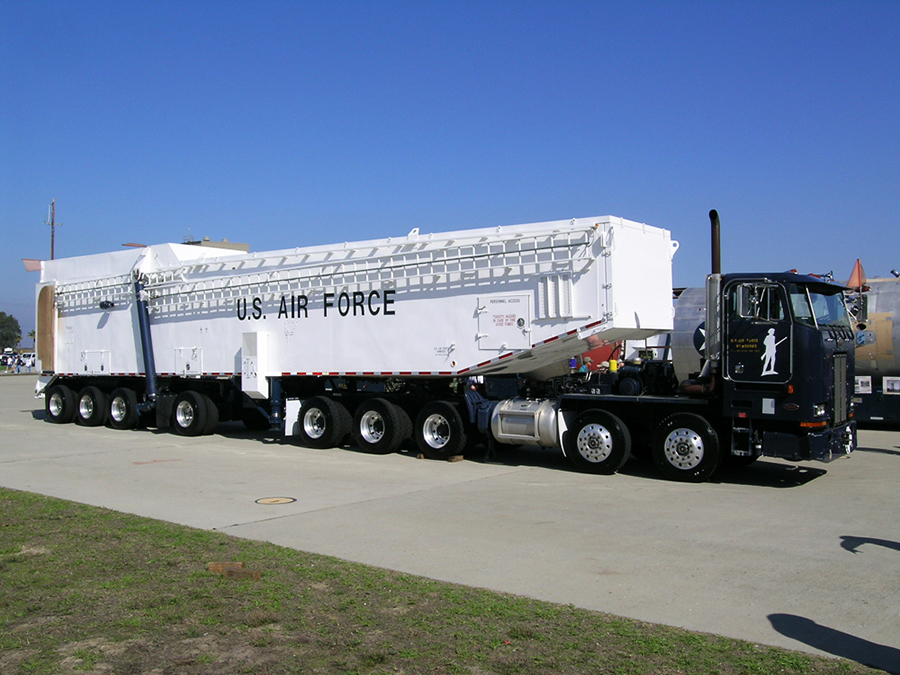
Transporter Erector Loader - TEL
Missile Maintenance Teams
Each Air Force Missile wing have a Missile Maintenance Squadron who are tasked with the responsibility of maintaining the immediate launch readiness of 150 Minuteman III missiles and the 15 Launch Control Facilities (Missile Alert Facilities) that are spread out over multiple thousand square miles of its missile complex.
The maintenance team remove and replace missiles, reentry systems (warhead) and guidance sets; they repair any security system issues, command and control, electrical systems and environmental control systems.
Maintenance technicians also perform periodic maintenance inspections and perform corrosion control work to sustain the Launch Facilities and Launch Control Facilities.
Within the maintenance squadron, there are a number of different maintenance technicians who have specialized training to perform specific maintenance duties on the numerous components of the Minuteman weapons system.
These technicians belong to the following teams. The Electro-Mechanical Team, (EMT); Missile Maintenance Team, (MMT); Missile Handling Team, (MHT); and Facilities Maintenance Team, (FMT).
Electro-Mechanical Team
In maintaining the electrical and mechanical components that are assigned to the Electro-Mechanical Team, their task lists are one of the most comprehensive job lists of any other of the maintenance teams. The EMT technicians are also highly trained to know the basic operational and trouble shooting information regarding every system in place at a Launch Facility, as well as the Launch Control Center at the Launch Control Facility.
The EMT technicians maintain the Launch Facility security systems (Inner Zone and Outer Zone Security) and the locking mechanism systems. They are versed in maintaining and trouble shooting the Command and Control communication, assuring the missile will be launched if and when it is given the command to do so.
The Minuteman missile support racks contained in the Launch Facility are also maintained by the EMT team, as well as the backup power supplies, including the generator in the Launch Support Building, and the backup battery system in the LF. The team is also responsible for the computer guidance programming and the cooling systems. Given the complexity of the multitude of systems that falls under the purview of the Electro-Mechanical Team, these men and women have a significant number of tasks to keep them busy.
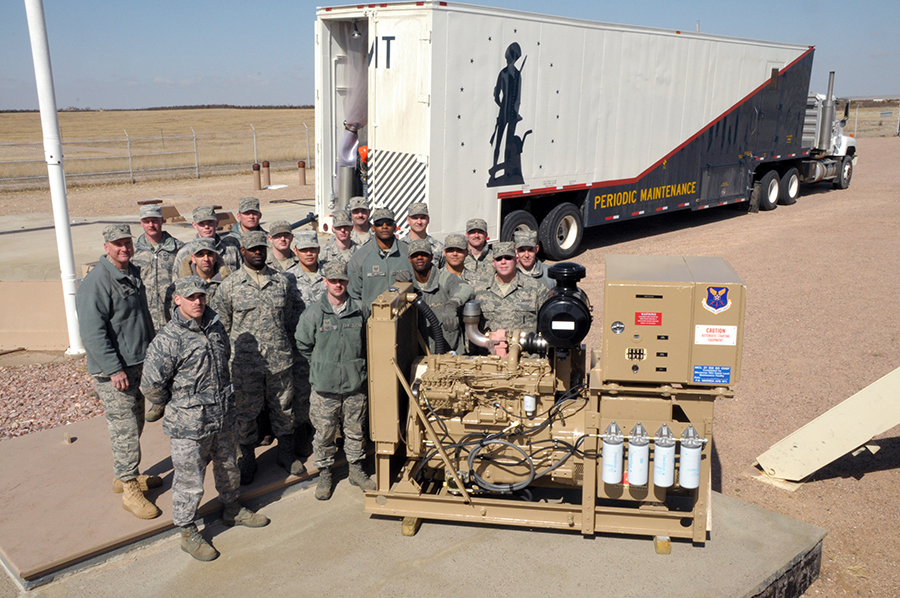
Periodic Maintenance Team Replacing An LSB Generator
Missile Maintenance Team
The Missile Maintenance Team is tasked with the most physically strenuous job within the Maintenance Squadron. The MMT team primary works in the launch tube, working with the missile umbilical system, the guidance computer on the Post Boost Vehicle, and the warhead on the missile. The MMT technicians get to haul the over 200 pound work cages and other large and heavy pieces of equipment up and down the Personnel Access tube.
The Missile Maintenance Team are responsible for testing and servicing all of the ignition cabling and explosive ordinance for the missile. The MMT also inspects and maintains the missile suspension system, which is extremely hazardous given the size of the suspension system and the tension resting on the suspension system, which is supporting 78,000 pounds of a Minuteman III missile.
The MMT team maintains the equipment used to operate the Launcher Closure Door that includes 4 Ballistic Gas Generators that push open the 110 ton Launcher Closure Door with a force equivalent to 5 sticks of dynamite.
The Missile Maintenance Team are specially trained to remove and replace the Missile Guidance System, the Post Boost Vehicle and the Reentry Vehicle - the Minuteman missile's warhead. The MMT team are also tasked with the responsibility of transporting and keeping a critical eye on these critical missile components as they travel from the missile base to the Launch Facility, which always includes a large Security Task Force, to assure the security of the weapon system components.
Missile Handling Team
The Missile Handling Team, MHT, find that their job duties are divided between performing their work tasks at the Air Force missile base, and at the Launch Facility itself. They oversee the shipping and receiving of Minuteman missiles by rail or aircraft, as well as transporting the missile to and from the Launch Facility.
When the MHT is at the Launch Facility itself, they are directly involved in the installation or removal of the Minuteman missile's 3 solid rocket fuel booster stages. There is a significant degree of stress involved when the Missile Handing Team is transporting and handling a potentially highly explosive 60 foot long Minuteman missile. The missile itself has to be protected from damage and kept in a precise temperature controlled environment, and great care needs to be provided at all times as to prevent any stress fractures in the solid rocket fuel. Any defects that occur during any of the stages of loading, transporting and placing the Minuteman missile into the Launch Facility could contribute to the failure of the missile being able to launch.
One character feature about the solid fuel used in the rocket boosters on the Minuteman missile, is that once anything ignites the rocket booster, there are no known agents that would extinguish the fire. The solid fuel provides its own oxidant, and will burn at several thousand degrees Fahrenheit both under water or in a vacuum, until the solid fuel is depleted.
Facilities Maintenance Team
The Facilities Maintenance Team has the never ending task of assuring that the Launch Facilities and the Launch Control Centers are at a specific level of temperature and humidity control. The FMT team makes sure that all of the sites are supplied with primary electrical power supplied from the commercial power grid, or standby power from a backup generator. Given the variable weather that can be found at a number of these Air Force missile wings (North Dakota, Wyoming, Montana), where there are storms that knock out commercial power, snow, blizzards, ice, rain and heat variables that can consist of temperatures at 40 degrees in the morning and 100 degrees in the afternoon, make the Facilities Maintenance Team a never ending task.
The FMT team also inspect and maintain the sump pumps that assure that the sites are drained from groundwater and rain water seepage. The Launch Control Facility and Launch Facility lighting systems, that provide security as well as light for the maintenance teams to work at night, also fall under the purview of the Facility Maintenance Team.
At times, the FMT technicians are asked to help out supporting maintenance teams, such as the Corrosion Control Teams, (CCT), Pneudraulics, (PNEU), or the Periodic Maintenance Teams, (PMT).
Missile Maintenance Squadron
All in all, the Missile Maintenance Squadron with their multitude of specific maintenance specialties are constantly faced with known and unknown challenges, in keeping the Minuteman missile weapon system up and running smoothly, as error free as possible. All of this is accomplished with a missile complex that is spread out from anywhere between 10,000 to 13,000 plus square miles.
Missile Maintenance History
Transporter Erector Loader History
In researching the various components of the Minuteman missile system, this author discovered early on that finding information about the early versions of the Transporter Erector Loader was not available. After a number of years trying to find any technical specifications regarding the TEL, the research finally produced the much desired information on this intriguing tractor trailer.
The Transporter Erector Loader, TEL, was built back in 1963 by Boeing, GMC and Cessna Aircraft. The design put forth concentrated on the ability to use the Transporter Erector on public roadways that would require minimal special permits. The TEL transported the entire Minuteman missile, without the warhead, from the base out to the Launch Facility. The trailer was built by Cessna, who designed and built the monocoque container. Large five section hydraulic actuators would raise the trailer to vertical and a winch inside the container with the capacity to move on ball slides to the front and back, left and right would then lower the missile down into the Launch Tube.
The trailer was 65 feet long, 10 feet wide, 13 feet tall and had approximately 8030 cubic feet of interior space. The trailer was environmentally controlled by the tractor, with heat being supplied by the GMC built V-12 engine, called the "Twin-Six". They installed a Pontiac air conditioning compressor on the GMC engine, and in addition to an A/C evaporator installed inside the trailer, enabled the Missile Handling Team to keep the Minuteman missile warm or cool, dependent on the weather and season.
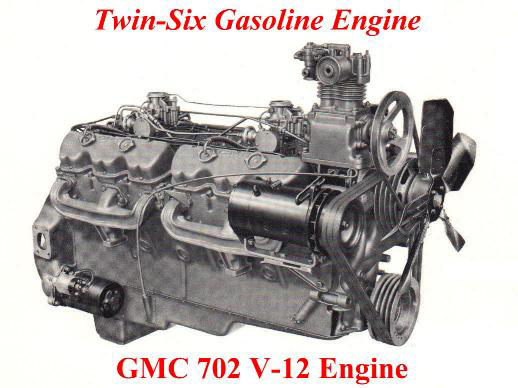
GMC "Twin Six" V-12
GMC "Twin Six" - V-12
The Transporter Erector Loader was pulled by a specially designed 1963 GMC tractor. The engine was built by GMC. It was a V-12 cylinder engine that was called the "Twin-Six", which supplied power to the four axle tractor and three axle missile trailer. GMC used a five speed main transmission and a two speed auxiliary.
The Twin-Six gasoline fueled twelve cylinder engine was often mistaken as two V6s welded together, but was actually made from a single casting. It used four separate exhaust manifolds, two separate carburetors, and two separate distributors that were driven off a single distributor drive. The Twin Six displaced 702 cubic inches and produced approximately 275 horsepower with 585 foot pounds of torque.
Given that the Twin Six was not two V-6 GMC blocks welded together, these two engines still had 56 major parts that were interchangeable between the Twin-Six and the GMC V-6 engines, which allowed them to provide greater parts availability and standardization. The 12 cylinder GMC was designed for hard work and long life, with a reported lifetime of 200,000 miles before the need of an overhaul.
When empty, the TEL could top out at about 30 mph, maybe 35 miles per hour. When fully loaded, the original Transporter Erector Loader was most certainly slow. When the TEL had to climb the steep grade of Belt Hill on Highway 87, 23 miles east of Malmstrom Air Force Base, the Transporter Erector Loader slowed to a crawl of 2 to 3 mph. In the early days of using the TEL, if the Missile Handling Team had to go out to Sluice Boxes State Park, which is further east from Malmstrom AFB, they had to take out a D6 Caterpillar the day before, to help push the TEL up the hill.
There were many times that necessitated the Missile Handling Team having to leave Malmstrom AFB at 0200 to allow them the time to get out to the launch facility by daybreak.
Traveling in the cab of the tractor proved to be extremely noisy, given the driver and passenger were essentially sitting on top of the V-12 engine. They often times brought along ear plugs or ear muffs to suppress the noise.
As the Transporter Erector Loaders got older, the rubber gasket that sealed the engine from the interior of the cab would crack, allowing heat from the engine to make the interior of the cab quite warm. During the warmer months of the year, things got very warm in the cab. The air conditioning compressor driven by the Twin Six was for the trailer and the missile inside, not the interior of the cab.
One final photograph below, is of the Transporter Erector Loader that can be seen at the Malmstrom Air Force Base museum. In the photograph above, taken in 2007, the TEL had seen many days and seasons in the sun, rain, ice and snow. Malmstrom AFB decided to restore the tractor by painting it and installing new tires. The photo below shows a number of Airmen delivering the TEL back to its home next to the museum.
